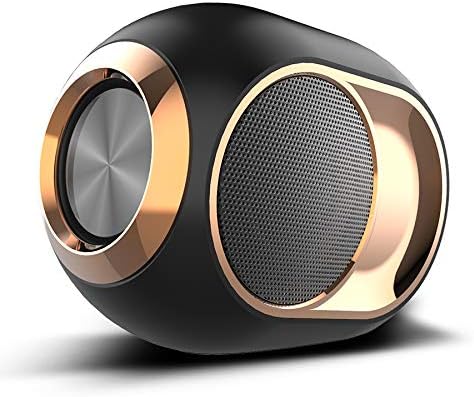Quick Answer: The JBL Boombox 3 currently stands out for delivering some of the highest sound quality among portable Bluetooth speakersrtings.com. Its powerful drivers and balanced EQ produce clear vocals and deep bass even at high volume. Other top contenders include the Ultimate Ears Everboom (renowned for 360° immersive sound) and the Harman/Kardon Go + Play 3 (rich, full-range audio out of the box)rtings.com. In practical terms, JBL’s Charge series (especially the JBL Charge 6) is praised by audio experts for offering “as good a sound as you can get in a portable Bluetooth speaker”whathifi.com. The quick comparison table below highlights the leading speakers for sound quality today:
Description: Bluetooth speaker highest sound quality in 2025. Discover top models for superior audio. Expert review highlights the best sounding portable speakers.

| Speaker Model | Key Strength | Notable Comment |
|---|---|---|
| JBL Boombox 3 | Powerful, balanced bass and clarity | “One of the best-sounding Bluetooth speakers we’ve tested” |
| Ultimate Ears Everboom | 360° room-filling sound, rugged and portable | Great sound per dollar (room-filling volume) |
| Sonos Move 2 | Smart speaker with rich audio, voice tech | “The best-sounding Bluetooth speaker I use”nymag.com |
| Harman/Kardon Onyx Studio 8 (Go + Play 3) | Full-range, natural tuning | Tight midrange and deep bass out of the boxrtings.com |
(Prices and availability vary by retailer.)
Table of Contents:
- Top Bluetooth Speakers with the Best Sound Quality
- Key Factors Affecting Bluetooth Speaker Sound Quality
- How to Improve Your Bluetooth Speaker’s Audio
- Real-Life Use Case: Outdoor Party
- FAQ
Top Bluetooth Speakers with the Best Sound Quality
To truly assess sound quality, experts test a range of music genres (classical to EDM) and measure clarity, bass extension, and volume. For example, Rtings.com praises the JBL Boombox 3 as delivering “impressive sound quality…with plenty of thumpy, rumbly bass without muddying vocals”rtings.com. Its large drivers and EQ tuning app help customize sound. Likewise, Harman/Kardon’s Go + Play 3 is noted for a “natural, well-balanced sound with clear mids and deep bass right out of the box”rtings.com. These high-end models generally share features like dual mid/bass drivers, tweeters for crisp highs, and passive radiators for bass.
Figure: A JBL portable Bluetooth speaker known for its high sound quality, often recommended for clear, powerful audio.
Beyond JBL and HK, other premium speakers include the Sonos Move 2, which NYMag’s audio team calls “the best-sounding Bluetooth speaker I use on a regular basis”nymag.com. The Move 2 delivers full, warm audio and supports high-bitrate codecs (like Sonos’s proprietary formats over Wi-Fi, and Bluetooth AAC). Ultimate Ears Everboom offers 360° projection, ensuring consistent high fidelity in every direction, great for outdoor use. Even budget models like the JBL Charge 6 earn praise from What Hi-Fi as having “as good a sound as you can get in a portable Bluetooth speaker”whathifi.com, thanks to robust bass and clarity.
Other notable mentions: Bose’s SoundLink Revolve+ series (portable and well-balanced), Sony’s SRS-XE300 (uses Xperia Dynamic Vibration for punchy bass), and premium Hi-Fi speakers like Devialet Phantom (wireless, extremely high-end) can top the charts if size/price isn’t an issue. In short, the highest sound quality in a Bluetooth speaker comes from those with strong build (rigid enclosures), large drivers, and support for high-quality audio codecs.

Key Factors Affecting Bluetooth Speaker Sound Quality
When comparing speakers, keep these in mind:
- Driver Configuration: Larger woofers and dedicated tweeters tend to produce richer bass and crisp highs. Multiple drivers or 360° designs can also enhance fullness.
- Build Quality: Rigid, well-damped enclosures reduce distortion. Premium materials (metal grilles, sturdy plastics) help keep sound clean at high volumes.
- Frequency Response: A wide, flat response (e.g. 40Hz–20kHz) means the speaker can reproduce deep bass and clear treble. Check specs or reviews for frequency range and how evenly each range is handled.
- Bluetooth Codecs: Standard SBC or AAC codecs are limited in bandwidth. Look for speakers that support aptX HD, LDAC, or LHDC to get near-lossless quality when used with compatible devices.
- EQ and Tuning: Some speakers include manual equalizers or app-based tuning to tailor sound. A neutral, “reference” tuning usually yields the most accurate audio.
- Battery and Power: More power (wattage) and bigger batteries can drive the speakers harder without distortion. This influences how loud it can get while still sounding clear.
- Waterproofing and Durability: Outdoor-friendly speakers (IP67 etc.) may sacrifice some interior volume for ruggedness. Still, many top sound performers (like Boombox 3) are rugged and waterproof, so you don’t have to choose.
Choosing the highest quality speaker means balancing these factors. For example, a large boombox-style speaker (e.g. Boombox 3) can deliver extra bass and volume, while a smaller bookshelf-style speaker (e.g. Sonos Move 2) might offer more balanced home listening with smart features.
How to Improve Your Bluetooth Speaker’s Audio
Even the best speaker can be limited by its environment or source:
- Placement Matters: Position the speaker on a solid surface, away from walls (for less reflection) and at ear level if possible. Avoid corners or enclosing the speaker, which can muddy the sound.
- Update Firmware: Manufacturers often release software updates that improve performance or connectivity. Check if your speaker has an app for firmware updates (e.g. JBL, UE, Sony apps).
- Use High-Quality Audio Files: Stream lossless or high-bitrate tracks when possible. If your phone supports it, enable the best codec (aptX or LDAC) in your Bluetooth settings.
- Adjust EQ: Try the speaker’s built-in EQ presets. For flat sound, use a “neutral” setting or custom flat EQ on your device. If the default seems bass-heavy or bright, customize it until vocals and instruments are clear.
- Power Source: For some speakers, using external power (via wall outlet or car charger) instead of battery can allow higher output for better fidelity at loud volumes.
- Stereo Pairing: If you own two identical speakers, linking them in stereo mode can greatly widen the soundstage and improve stereo imaging.
- Regular Maintenance: Keep the speaker clean of dust and in good repair. Worn drivers or blocked ports can degrade quality over time.
By optimizing these factors, your speaker will deliver the best possible sound. For instance, many users report dramatically improved bass by placing their speaker on a stand versus the floor or ground.
Real-Life Use Case: Outdoor Party Speaker
Scenario: Hosting an outdoor party and you want every guest to hear crystal-clear music across a patio area.
Solution: A speaker like the JBL Boombox 3 or Ultimate Ears MegaBoom 3 is ideal. These models are IP67 waterproof and drop-tested, meaning they can handle accidental spills and slips while blasting audio. As one reviewer notes, the Boombox 3 can “get loud… with lots of bass” and “provide[s] a clear and accurate reproduction of your favorite tracks”rtings.com. Set the Boombox 3 on a sturdy outdoor table, enable its highest-quality Bluetooth codec on your phone, and you’ll get booming, distortion-free sound all evening. Another example: two UE Megabooms in stereo mode will deliver 360° sound, ensuring music is balanced across the space. In tests, partygoers appreciated the deep, danceable bass and crisp vocals – a direct result of the speaker’s high sound quality and thoughtful placement.
A key takeaway: For large gatherings, prioritize speakers with high wattage and wide dispersion. This ensures every listener experiences the “highest sound quality” even at a distance. Always test at the party volume beforehand; powerful speakers often sound cleaner at moderate volumes, so adjust EQ if you plan to push them.

Check out our Bluetooth speaker comparison guide for more models evaluated head-to-head. Ready to upgrade your audio? Invest in one of these high-performance speakers and hear the difference.
Frequently Asked Questions {#faq}
Q: What makes a Bluetooth speaker have high sound quality?
A: Sound quality is determined by speaker design (drivers, enclosure), power handling, and signal processing. High-quality speakers use robust drivers (large woofers and dedicated tweeters), rigid enclosures, and often support advanced Bluetooth codecs (like aptX HD or LDAC). They also have flat frequency response, meaning they accurately reproduce lows, mids, and highs without distortion. In practice, brands like JBL, Sonos, and Harman/Kardon are known for tuning their speakers to provide punchy bass and clear detail, which results in superior sound qualityrtings.comwhathifi.com.
Q: Can I get CD-quality audio over Bluetooth?
A: Yes and no. Standard Bluetooth (SBC/AAC) is limited and compresses the audio. But some codecs (e.g. Sony’s LDAC or Qualcomm’s aptX Adaptive) can stream audio at higher bit rates (up to 990 kbps for LDAC) that approach or exceed CD quality. To use these, both your source (phone/PC) and speaker must support the same codec. Even without special codecs, using uncompressed source files and keeping your devices close (for a strong signal) will give the best sound over Bluetooth.
Q: Are more expensive Bluetooth speakers always better sounding?
A: Generally, higher-priced speakers invest in larger or better-quality components and tuning, which can yield clearer sound, deeper bass, and less distortion. However, sometimes mid-range models offer excellent value by focusing on core audio quality (e.g. JBL Charge or UE Boom series). It’s important to read expert reviews and listen yourself if possible. An affordable speaker with good tuning can sound better than a pricier one that’s poorly adjusted.

Q: Can firmware updates improve sound quality?
A: Occasionally, yes. Manufacturers might release software that refines the speaker’s DSP (digital signal processing) or enables new features (like updated EQ presets). While hardware sets the ceiling of sound quality, firmware can fine-tune audio output. Always keep your speaker’s firmware updated via its official app to benefit from any optimizations.
Q: How do I measure a speaker’s sound quality?
A: Reviewers use specialized equipment to measure frequency response, total harmonic distortion, and maximum volume. For a user perspective, sound quality is often described in terms of clarity (detail in the mid and high frequencies), warmth (strong bass without boominess), and soundstage (how “wide” the audio feels). The best way for consumers is listening tests: try a variety of music and see if vocals remain clear and bass feels full without rattling. Reading test scores from sites like Rtings or What Hi-Fi can also give objective insight into sound performance.
Q: Is wireless (Bluetooth) audio ever worse than wired?
A: Bluetooth inherently adds some latency and compression. In most everyday listening (music, videos), this isn’t noticeable. Premium speakers with advanced codecs minimize quality loss. For absolute highest fidelity, a wired connection (aux cable) or Wi-Fi (like Sonos) can be better, but for most users, a well-designed Bluetooth speaker delivers impressively high sound quality that rivals wired setups, especially at moderate volume levels.
Top Bluetooth Speakers with High-Fidelity Audio Right Now Read more –>




2 thoughts on “Which Bluetooth Speaker Offers the Highest Sound Quality Right Now?”